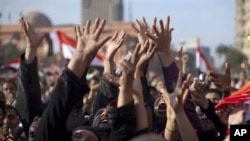Much is made of the role of Facebook, Twitter and other social media in Egypt’s revolution. But when President Hosni Mubarak’s government cut the country’s Internet lines, demonstrations still grew. Organizers talk about the about the grassroots supply lines that kept them going for 18 days, ultimately forcing Mr. Mubarak’s resignation.
Facebook and other social media mobilized protesters toward Cairo’s Tahrir Square. But it was the makeshift hospitals, food tents and toilets that allowed them to stay there for 18 days straight.
Mohamed Radwan returns to the site of protests he helped to organize. "They would go up to them, pass the water, people would take a sip. A clinic started showing up," he said.
Cars idled behind barricades while volunteers unloaded supplies daily, ferrying them to protesters sleeping in the square. Beforehand, organizers even ran dress rehearsals on Cairo sidestreets. "They actually went into certain neighborhoods, walked down alleys. Security forces would face them," he said.
At the same time, another leaderless army of tech-savvy youth drummed up support online. University student Nour Ramadan describes the division of labor in and outside of Tahrir Square. "You had people who were taking care of the groups on Facebook, to spread the word even more, right."
Ramadan's friend Amin Abu Hashem has advice for others who may be organizing similar protests. "Have the maximum number of people. Invite everybody, invite people you don’t even like. You’re going to go somewhere," he said.
Tahrir Square is both back to normal, and changed forever. It is unclear whether what happened here can be duplicated elsewhere - a mix of high-tech communication and low-tech hard work on the ground.










